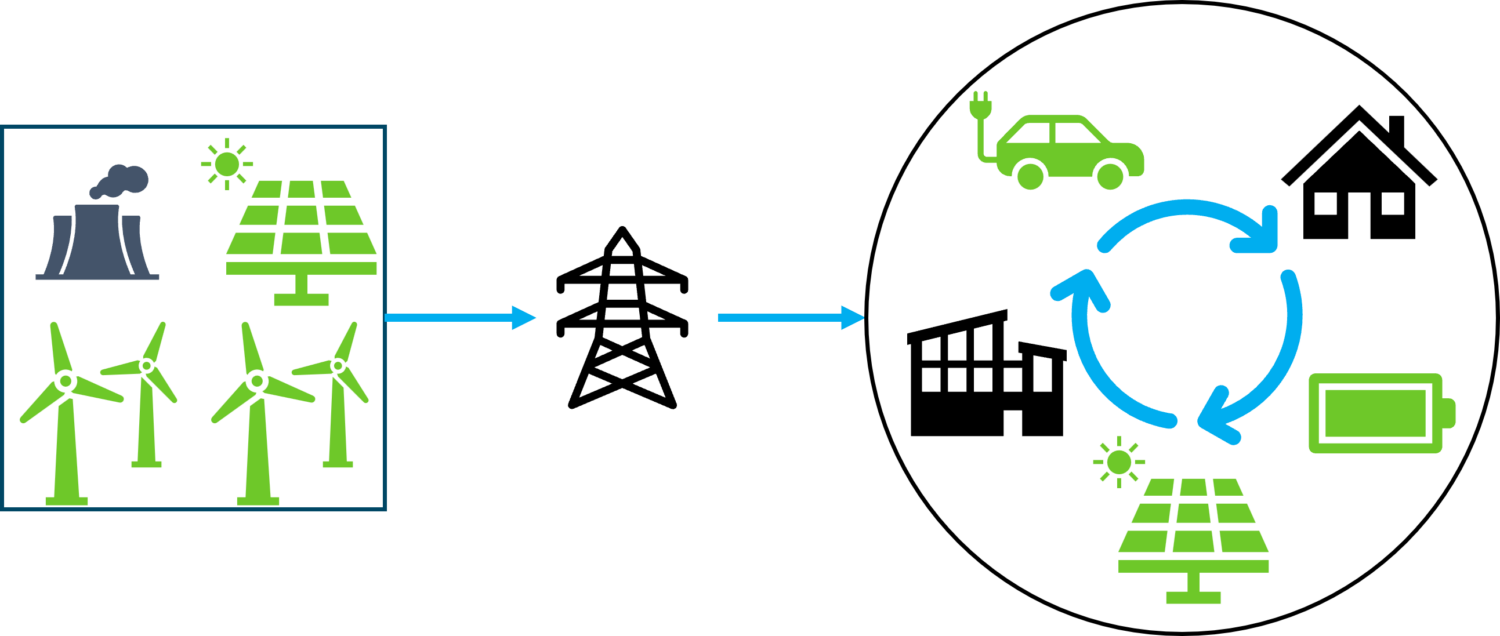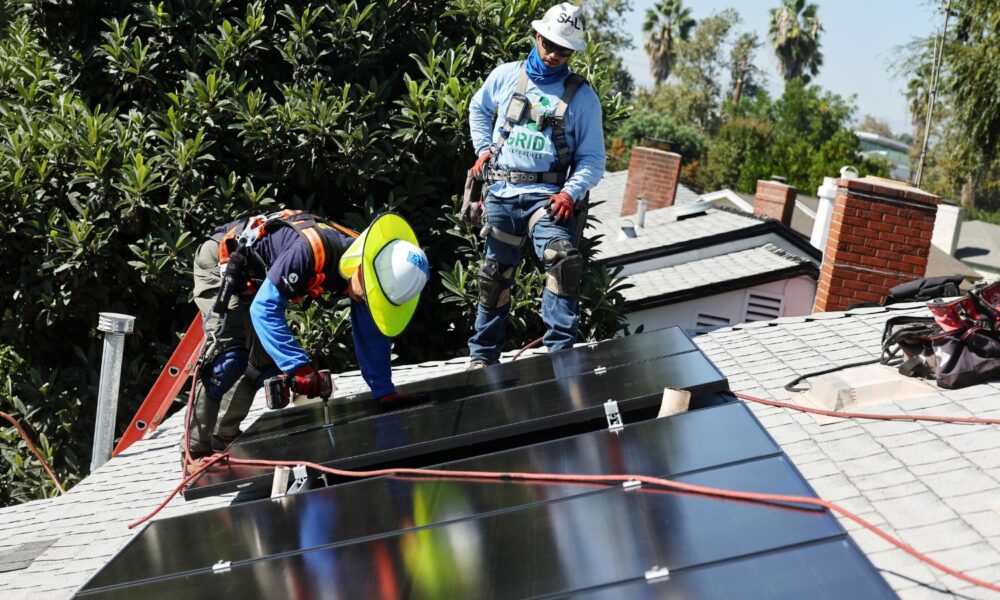Picture a home with solar panels on the roof and a battery mounted on an exterior wall, storing energy from the solar panels during the day for use at night. This ‘solar+storage’ system is an increasingly common sight across the country, with up to 25% of new solar installations including attached storage.
It might be easy to think of this set-up as operating in isolation: only impacting the household and its occupants. But depending on the way this system is configured and operated, it can provide significant benefits not only to the homeowner, but to the neighborhood, the greater community, and beyond.
Those benefits can be economic gains in the form of rebates or reduced utility bills, enhanced public health via reduced pollution, improved safety through backup power for medical equipment, or environmental justice through energy independence, among several other benefits.
Understanding this rapidly changing system—where power producers are tapping directly into “the grid” —is key to maximizing these potential impacts. But to understand this incredibly complex system (like the web of regulations across regions, states, and utilities, or the ways that some systems can provide overlapping benefits), we’ve got to zoom out a bit first.
What is “the grid”?
Before we can figure out what this solar + storage system is, we need to understand the context it fits into: the grid. The electric grid is the generic term for the complicated system of power plants and wires that provides electricity to 92% of the world’s inhabitants. Traditionally, the grid could be thought of as containing three main components: generation, transmission, and distribution, with power flowing through them in that order.

Generation consists of large, centralized power plants that produce electric energy. For close to a century, coal, nuclear, and large hydroelectric plants dominated this mix. Transmission is the system of large, high-tension power lines that carry power away from these plants and across long distances. Distribution is the system of smaller wires and other equipment that takes the energy from transmission lines and delivers it to buildings, homes, and businesses.
A metaphor for the grid is modern factory farming; large farms generate produce, meat, and dairy products; ships, trains, and trucks transmit these products around the world; then grocery stores and delivery trucks distribute these products to the end users.
How is the grid changing?
The rapid advances in wind turbine, solar panel, and battery technology in recent years mean that generation no longer needs to be confined to large, centralized power plants connected to transmission lines far from where energy is used. Now, homeowners, businesses, and communities can install solar panels on rooftops and produce their own power, which can also be exported to the grid where it can be used by their neighbors. This change is having major impacts on the grid.
To continue the farming metaphor, this change to the grid is similar to changes in the food production system with the growth of community gardens, farmers’ markets, and community supported agriculture. All of these innovations mean that consumers can increasingly produce their own food, or support their neighbors in producing food, reducing reliance on the large and complicated system of corporate farms and grocery chains.

This ability to source and share power locally has significant environmental justice and energy equity implications, giving people and communities greater control over where their power comes from, and how it impacts them. A more distributed model of the grid enables lower energy costs, energy independence, and enhanced local resilience. Communities can choose cleaner power sources to address public health and environmental concerns. In a later post, we’ll dive deeper into these benefits and the environmental justice implications of a more distributed grid, with a discussion of barriers and solutions.

With these newer technologies and changing trends in how the grid operates, we now need to distinguish between bulk generation—the “conventional” generators that sell power (in bulk) onto the transmission system, and distributed generation, the growing sector of power producers connected directly into the distribution system. Because some types of distributed generation (such as batteries) also use energy, we use the more general term distributed energy resources (DER) to capture both types of resources. But what else might be included under the DER umbrella?
How do we define distributed energy resources?
The energy industry has been grappling with this question for a while, and stakeholders offer different definitions in different contexts, depending on whether you look at the grid from a regulatory, technical, or market perspective.
A technology and regulatory perspective is provided by the Institute of Electrical and Electronics Engineers (IEEE), the body that defines the technical standards for how DERs physically interface with the grid. In standard 1547, IEEE provides a narrow definition for DER: “A source of electric power that is not directly connected to a bulk power system. DER includes both generators and energy storage technologies capable of exporting active power to an electric power system.”
This definition works well when considering individual systems such as the residential solar+storage system we started with. But another benefit to DERs is their ability to work together and coordinate responses to different conditions on the grid, enhancing the benefits previously discussed.
This coordination typically takes one of two forms—through physical integration as a microgrid, or through virtual coordination as a virtual power plant (VPP), both of which will be the topics of upcoming posts in this series.
To better capture this type of broad coordination, a broader perspective taking the market viewpoint is helpful. Here, the best definition is provided by FERC (the Federal Energy Regulatory Commission), the independent government agency responsible for regulating the bulk generation and transmission systems. FERC uses a broad definition for DERs in Order 2222: “Any resource located on the distribution system, any subsystem thereof or behind a customer meter.” Examples listed by FERC include batteries, generators, demand response, energy efficiency, electric vehicles (EVs), and EV chargers. (“Behind the meter” refers to resources in a customer’s home, business, or building that serve their own needs before supporting the grid.)
FERC provides a broad definition because it recognizes that all of these resources, when properly managed, can provide different resources to the grid at different times, and should be compensated for the value they provide to encourage market participation and maximize that value.
Putting the pieces together
Defining what a distributed energy resource is—and isn’t—depends on context. But regardless of how these technologies are labeled, what matters most is how they’re used, how they interact with the grid, and the benefits they provide. As more homes, neighborhoods, and communities adopt them, the potential for DERs to reshape our grid and our relationship to it grows dramatically. Just as local farms can strengthen food systems, local energy can strengthen power systems.
In the next parts of this series, we’ll explore how DERs can be organized into microgrids and virtual power plants, and how they can support equity in the power system of the future—one where communities don’t just consume power but help shape the grid around their needs.

